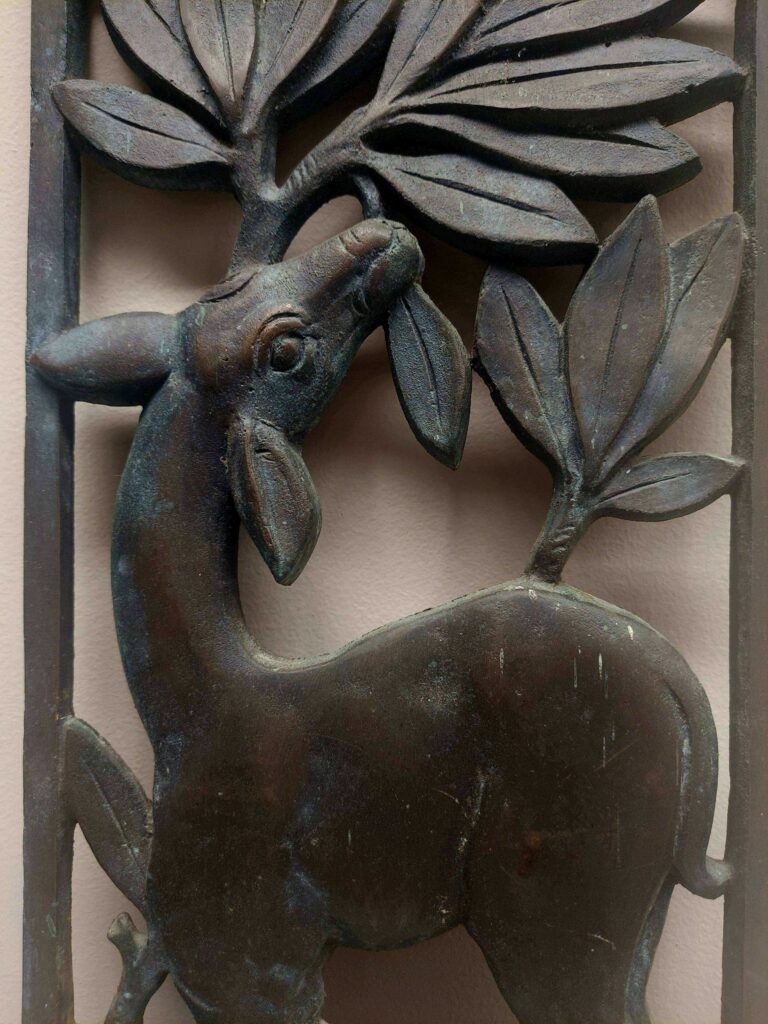July 7 – October 15, 2023
Curated by Melissa Sagaseta ’22

Image credit: Fritz Paul Zimmer (German American 1884-1975), One of two deer design fireplace screens, Bronze, Dimensions various, Date unknown, Courtesy of the Philip Weltner Library Archives, Collection of Oglethorpe University
This exhibition of plaster and bronze sculptures, architectural drawings, set designs, working tools and personal ephemera is drawn entirely from the archives of the Philip Weltner Library of Oglethorpe University.
Assuming the role of Professor of Fine and Applied Arts, Fritz P. Zimmer joined the Oglethorpe University faculty in September of 1930, and was named Dean of the Art department in 1932. Bringing with him a high level of artistic expertise and knowledge from prominent European Art schools, Zimmer dedicated his time at Oglethorpe to teaching the next generation of artists. His dry sense of humor, good-natured smile, and the highly valued skills he brought to the studio each day made a notable mark on his students, with many of them staying in contact with Zimmer until his death in 1975.
“Under his guidance, the gray clay seemed to magically take shape and become a thing of beauty. I know I express the feeling of his other students when I say that his classes stand out as very special, happy memories, and I am grateful that I had the chance to have studied under such a gifted and talented teacher.” (Sidney Davis ’73)
Zimmer also dedicated his time at Oglethorpe to creating bronze busts of notable faculty and beneficiaries, in order to honor their work and devotion to the university. In 1929, Zimmer sculpted the plaster cast of Oglethorpe University’s president (1915-1943), Dr. Thornwell Jacobs, who opened the doors of Oglethorpe at its present location on Peachtree Road in 1916. It was then sent to a German Foundry to be bronzed. In the same period, Zimmer completed another bust in recognition of OU’s Dean of School of Education, Dr. Herman J. Gaertner. A year later, in 1930, Zimmer presented the OU library with a bronze bust of Dr. J.T Lupton, Oglethorpe’s most generous benefactor, who received an honorary degree from OU (Doctor of Laws) in 1921, and for whom Lupton Hall is named.
Zimmer’s sculptures and architectural work were at one time found in more than 60 churches, the homes of private collectors, university campuses, local government buildings, and postal offices all across the South. In Georgia, this included the main entrance eagle pediments and reliefs on the UPS building in Columbus; Gainesville’s city hall pediments, the chapel of Atlanta’s First Baptist Church in Decatur, the sanctuaries of the Church at Wieuca and the Jewish Temple; a St. Thomas sculpture located at St. Thomas More Catholic Church, along with the state seals of Florida and Alabama.
Although time, urban planning, and lost records have misplaced some of Zimmer’s work, three of his sculptures continue to receive their well-deserved attention from visitors. One of these pieces is the bronze Deer (Reh) situated in the Southern Seasons Garden at the Atlanta Botanical Garden. Sculpted in 1923, Zimmer’s inspiration for the piece originated in Germany, where the artist befriended a deer while living in the Black Forest. Impacted by this interaction, Zimmer cast the deer in bronze before moving to the U.S. Gifted to the High Museum of Art by Arthur Montgomery, the sculpture is currently on an extended loan to the Botanical Garden.
This exhibition was curated by Melissa Sagaseta ’22 with guidance by Eli Arnold ’06, university librarian, and Elizabeth Peterson Jennings, director of the Oglethorpe University Museum of Art. Gallery Assistant Rosie Sanon ’26 provided additional insight with final layout and organization of the exhibition. The last known retrospective of Zimmer’s work was held in 1973 in the former OU Art Gallery, which occupied the same space as OUMA’s current Shelley and Donald Rubin Art Gallery.

